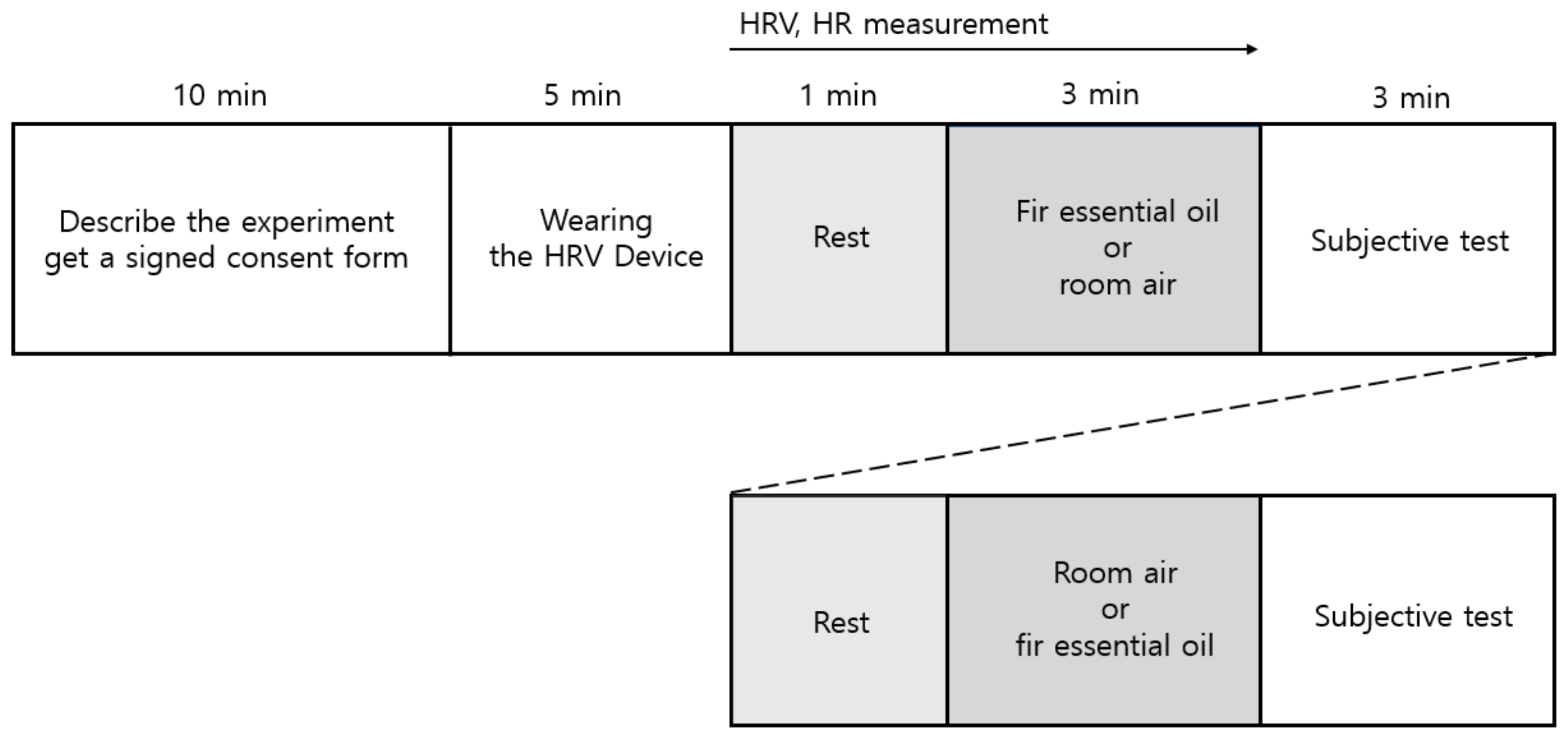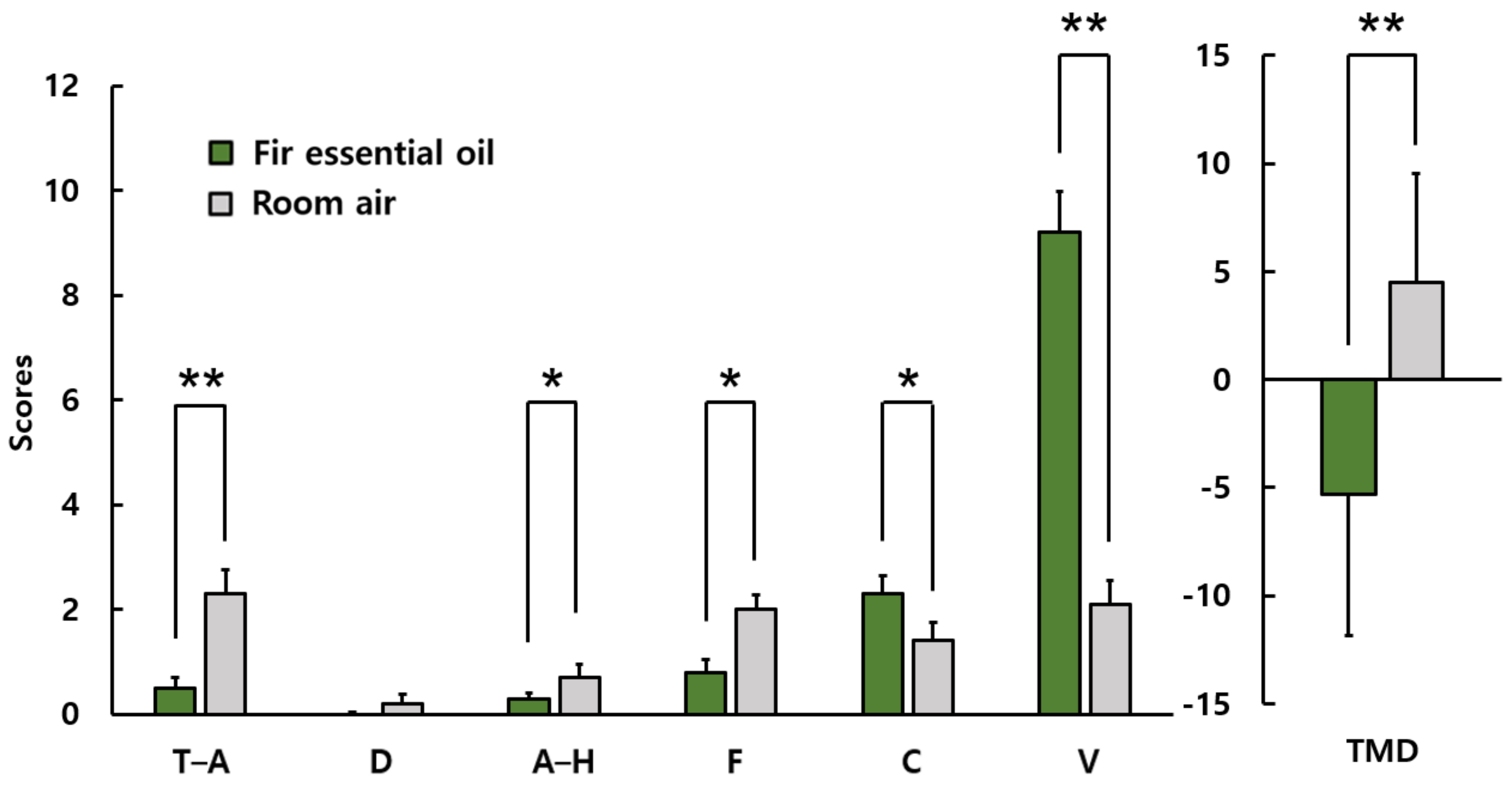Physiological and Psychological Relaxation Effects of Fir Essential Oil on University Students
Abstract
:1. Introduction
2. Materials and Methods
2.1. Participants
2.2. Olfactory Stimulation
2.3. Experimental Design
2.4. Physiological Measurement
2.5. Psychological Measurement
2.5.1. Profile of Mood State (POMS)
2.5.2. State-Trait Anxiety Inventory (STAI)
2.6. Data Analysis
3. Results and Discussion
3.1. All Participants
3.1.1. Physiological Measurement
3.1.2. Physiological Measurement
3.2. Sex Comparison
3.2.1. Physiological Measurement
3.2.2. Psychological Measurement
4. Conclusions
Author Contributions
Funding
Institutional Review Board Statement
Informed Consent Statement
Data Availability Statement
Acknowledgments
Conflicts of Interest
References
- Husky, M.M.; Kovess-Masfety, V.; Swendsen, J.D. Stress and Anxiety Among University Students in France During COVID-19 Mandatory Confinement. Compr. Psychiatry 2020, 102, 152191. [Google Scholar] [CrossRef] [PubMed]
- Díaz-Jiménez, R.M.; Caravaca-Sánchez, F.; Martín-Cano, M.C.; De la Fuente-Robles, Y.M. Anxiety Levels Among Social Work Students During the COVID-19 Lockdown in Spain. Soc. Work Health Care. 2020, 59, 681–693. [Google Scholar] [CrossRef] [PubMed]
- Rogowska, A.M.; Kuśnierz, C.; Bokszczanin, A. Examining Anxiety, Life Satisfaction, General Health, Stress and Coping Styles During COVID-19 Pandemic in Polish Sample of University Students. Psychol. Res. Behav. Manag. 2020, 13, 797–811. [Google Scholar] [CrossRef]
- Akdeniz, G.; Kavakci, M.; Gozugok, M.; Yalcinkaya, S.; Kucukay, A.; Sahutogullari, B. A Survey of Attitudes, Anxiety Status, and Protective Behaviors of the University Students During the COVID-19 Outbreak in Turkey. Front. Psychiatry 2020, 11, 695. [Google Scholar] [CrossRef] [PubMed]
- Kim, G.S.; Park, Y.J. A Qualitative Study on the Stress of Undergraduate Due to COVID-19. J. Korea Contents Assoc. 2021, 21, 644–651. [Google Scholar]
- Cibyl. Available online: https://cibyl.com/ (accessed on 2 April 2020).
- Omizo, M.M.; Omizo, S.A.; Suzuki, L.A. Children and Stress: An Exploratory Study of Stressors and Symptoms. Sch. Couns. 1988, 35, 267–274. [Google Scholar]
- Kim, N.J.; Lim, Y.S. The Verification of Intervening Effect of Youth Activity on the Relationship Between Stress and Life Satisfaction of Adolescents. Korean J. Youth Stud. 2012, 19, 219–240. [Google Scholar]
- Miyazaki, Y.; Park, B.J.; Lee, J. Nature therapy. In Designing our Future: Local Perspectives on Bioproduction, Ecosystems and Humanity; Osaki, M., Braimoh, A., Nakagami, K., Eds.; United Nations University Press: New York, NY, USA, 2011; Volume 10, pp. 407–412. [Google Scholar]
- Tanaka, A.; Takano, T.; Nakamura, K.; Takeuchi, S. Health levels influenced by urban residential conditions in a megacity–Tokyo. Urban Stud. 1996, 33, 879–894. [Google Scholar] [CrossRef]
- Park, B.J.; Tsunetsugu, Y.; Kasetani, T.; Kagawa, T.; Miyazaki, Y. The Physiological Effects of Shinrin-yoku (Taking in the Forest Atmosphere or Forest Bathing): Evidence from Field Experiments in 24 Forests Across Japan. Environ. Health Prev. Med. 2010, 15, 18–26. [Google Scholar] [CrossRef] [Green Version]
- Park, B.J.; Tsunetsugu, Y.; Kasetani, T.; Hirano, H.; Kagawa, T.; Sato, M.; Miyazaki, Y. Physiological Effects of shinrin-yoku (Taking in the Atmosphere of the Forest)—Using Salivary Cortisol and Cerebral Activity as Indicators. J. Physiol. Anthropol. 2007, 26, 123–128. [Google Scholar] [CrossRef] [Green Version]
- Ochiai, H.; Ikei, H.; Song, C.; Kobayashi, M.; Takamatsu, A.; Miura, T.; Kagawa, T.; Li, Q.; Kumeda, S.; Imai, M.; et al. Physiological and Psychological Effects of Forest Therapy on Middle-Aged Males with High-Normal Blood Pressure. Int. J. Environ. Res. Public Health 2015, 12, 2532–2542. [Google Scholar] [CrossRef] [PubMed] [Green Version]
- Naaz, F. Aromatherapy: The Practice of Aroma’s in Una ni Medicine. J. AYUSH Ayurveda Yoga Una ni Siddha Homeopath. 2017, 6, 20–26. [Google Scholar]
- Ikei, H.; Song, C.; Miyazaki, Y. Physiological Effect of Olfactory Stimulation by Hinoki Cypress (Chamaecyparis obtusa) Leaf Oil. J. Physiol. Anthropol. 2015, 34, 44. [Google Scholar] [CrossRef] [Green Version]
- Joung, D.; Song, C.; Ikei, H.; Okuda, T.; Igarashi, M. Physiological and Psychological Effects of Olfactory Stimulation with D-Limonene. Adv. Horti Sci. 2014, 28, 90–94. [Google Scholar]
- Ikei, H.; Song, C.; Lee, J.; Miyazaki, Y. Comparison of the Effects of Olfactory Stimulation by Air-Dried and High-Temperature-Dried Wood Chips of Hinoki Cypress (Chamaecyparis obtusa) on Prefrontal Cortex Activity. J. Wood Sci. 2015, 61, 537–540. [Google Scholar] [CrossRef]
- Yeon, P.S.; Lee, H.E.; Shin, C.S. Assay of Terpene Compounds Contained in the Tree for Forest Healing. J. People Plants Environ. 2015, 18, 333–339. [Google Scholar] [CrossRef]
- Fernandes, E.S.; Passos, G.F.; Medeiros, R.; da Cunha, F.M.; Ferreira, J.; Campos, M.M.; Pianowski, L.F.; Calixto, J.B. Anti-Inflammatory Effects of Compounds Alpha-Humulene and (−)-Trans-Caryophyllene Isolated from the Essential Oil of Cordia Verbenacea. Eur. J. Pharmacol. 2007, 569, 228–236. [Google Scholar] [CrossRef]
- Kawakami, K.; Kawamoto, M.; Nomura, M.; Otani, H.; Nabika, T.; Gonda, T. Effects of Phytoncides on Blood Pressure Under Restraint Stress in SHRSP. Clin. Exp. Pharmacol. Physiol. 2004, 31 (Suppl. S2), S27–S28. [Google Scholar] [CrossRef]
- Fujita, T.; Sezik, E.; Tabata, M.; Yesilada, E.; Honda, G.; Takeda, Y.; Tanaka, T.; Takaishi, Y. Traditional Medicine in Turkey VII. Folk Medicine in Middle and West Black Sea Regions. Econ. Bot. 1995, 49, 406–422. [Google Scholar] [CrossRef]
- Hong, J.S.; Kim, W.Y.; Koo, C.D. Effects of the Aromatherapy Program Using Fir Needle Essential Oil on Stress, Sleep Quality and Fatigue in Middle-Aged Women. J. People Plants Environ. 2018, 21, 433–443. [Google Scholar] [CrossRef]
- Baik, H.J.; Kim, H.J.; Jae, S.Y.; Yi, B.Y. Effects of Fragrance Components of Abies holophylla Max. on Stress Relief and Improvement of Vascular Functio. J. People Plants Environ. 2018, 21, 223–232. [Google Scholar] [CrossRef] [Green Version]
- Dayawansa, S.; Umeno, K.; Takakura, H.; Hori, E.; Tabuchi, E.; Nagashima, Y.; Oosu, H.; Yada, Y.; Suzuki, T.; Ono, T.; et al. Autonomic Responses During Inhalation of Natural Fragrance of “Cedrol” in Humans. Auton. Neurosci. 2003, 108, 79–86. [Google Scholar] [CrossRef] [PubMed]
- Ikei, H.; Song, C.; Miyazaki, Y. Effects of Olfactory Stimulation by α-Pinene on Autonomic Nervous Activity. J. Wood Sci. 2016, 62, 568–572. [Google Scholar] [CrossRef]
- Chen, M.C.; Fang, S.H.; Fang, L. The Effects of Aromatherapy in Relieving Symptoms Related to Job Stress Among Nurses. Int. J. Nurs. Pract. 2015, 21, 87–93. [Google Scholar] [CrossRef]
- Lee, H.E.; Shin, W.S.; Yeoun, P.S.; Cho, Y.M.; Yeom, S.H. Effect of Inhalation of Essential Oil (Chamaecyparis obtuse) on Stress and Depression in College Students. J. Korean Inst. For. Recreat. 2011, 15, 61–68. [Google Scholar]
- Koelega, H.S.; Köster, E.P. Some Experiments on Sex Differences in Odor Perception. Ann. N. Y. Acad. Sci. USA 1974, 237, 234–246. [Google Scholar] [CrossRef]
- Cain, W.S. Odor Identification by Males and Females: Predictions vs. Performance. Chem. Senses 1982, 7, 129–142. [Google Scholar] [CrossRef]
- Evans, W.J.; Cui, L.; Starr, A. Olfactory Event-Related Potentials in Normal Human Subjects: Effects of Age and Gender. Electroencephalogr. Clin. Neurophysiol. 1995, 95, 293–301. [Google Scholar] [CrossRef] [Green Version]
- Seubert, J.; Rea, A.F.; Loughead, J.; Habel, U. Mood Induction with Olfactory Stimuli Reveals Differential Affective Responses in Males and Females. Chem. Senses 2009, 34, 77–84. [Google Scholar] [CrossRef] [Green Version]








| Mean ± Standard Deviation | |||
|---|---|---|---|
| Parameter | Total (n = 26) | Female (n = 16) | Male (n = 10) |
| Age (years) | 21.5 ± 1.9 | 21.2 ± 2.1 | 22.0 ± 1.4 |
| Height (cm) | 166.5 ± 7.5 | 162.5 ± 5.3 | 172.9 ± 6.0 |
| Weight (kg) | 62.9 ± 11.1 | 58.4 ± 9.7 | 70.2 ± 9.3 |
| Body mass index (kg/m2) | 22.8 ± 0.2 | 22.1 ± 0.3 | 23.5 ± 0.2 |
Publisher’s Note: MDPI stays neutral with regard to jurisdictional claims in published maps and institutional affiliations. |
© 2022 by the authors. Licensee MDPI, Basel, Switzerland. This article is an open access article distributed under the terms and conditions of the Creative Commons Attribution (CC BY) license (https://creativecommons.org/licenses/by/4.0/).
Share and Cite
Kim, C.; Song, C. Physiological and Psychological Relaxation Effects of Fir Essential Oil on University Students. Int. J. Environ. Res. Public Health 2022, 19, 5063. https://doi.org/10.3390/ijerph19095063
Kim C, Song C. Physiological and Psychological Relaxation Effects of Fir Essential Oil on University Students. International Journal of Environmental Research and Public Health. 2022; 19(9):5063. https://doi.org/10.3390/ijerph19095063
Chicago/Turabian StyleKim, Choyun, and Chorong Song. 2022. "Physiological and Psychological Relaxation Effects of Fir Essential Oil on University Students" International Journal of Environmental Research and Public Health 19, no. 9: 5063. https://doi.org/10.3390/ijerph19095063






